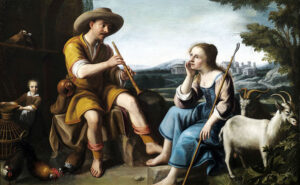Stravinsky, Pastorale
 Last week we focused on the rousing galop in Rossini’s William Tell Overture. But, as we noted, much of the work involves a pastorale scene portraying idyllic life in the Swiss Alps.
Last week we focused on the rousing galop in Rossini’s William Tell Overture. But, as we noted, much of the work involves a pastorale scene portraying idyllic life in the Swiss Alps.
A pastorale evokes shepherds and rustic rural life. The musical form has quite a long history. It can be traced back to Ancient Greece and the 6th century B.C. It continues to show up, for example in the 9th-century Carolingian Renaissance, the songs of the troubadours (11th-13th centuries), Renaissance madrigals, and early opera.
It became a favorite form for Christmas music in the 17th and 18th centuries, beginning in Italy and spreading throughout Europe. You might immediately think of the Pastoral Symphony in Handel’s Messiah (1741).
The pastorale is often characterized by melodies harmonized in parallel thirds and a drone or sometimes a gentle rocking rhythm in the bass. Beethoven uses some of these techniques in his Pastoral Symphony and in the Piano Sonata Op. 28. And you will hear the same features in this week’s selection: the rocking rhythm in the bass, drones, and, at times, the parallel thirds. But the form is ultimately more about the imagery than any specific musical technique.
Stravinsky made several versions of his Pastorale. Originally composed for piano and soprano in 1907, he recast it in 1923 for soprano and four woodwinds. Ten years later, he created a version for violin and soprano and another version for violin and woodwinds (the version presented here). The two versions from 1933 were also lengthened, although the work remains quite short.



